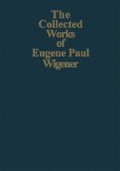Abstract
Though the expression “S matrix” was coined by Heisenberg [1], the idea of epitomizing the collision process by specifying only the final state of the collision products, i.e., the concept of the collision matrix, was first advanced by Wheeler [2]. He was seeking—and achieving—a concise description of the collision process. Heisenberg’s motivation for introducing the collision matrix was his belief, at the time he wrote his paper, that the detailed structure of the system during the collision is unobservable; only the final state, when the collision products are outside one another’s range of influence, can be ascertained experimentally. Heisenberg expected the S matrix to become, in one form or another, a substitute for the concepts of field theory, since the quantities with which that theory deals are of doubtful observability. This idea is, of course, the basis of much modern thought, embodied in dispersion theory, which will not, however, be the subject of this essay. Rather, we will go one step further in the direction that motivated Heisenberg, to query the extent to which the elements of the collision matrix are observable.
Access this chapter
Tax calculation will be finalised at checkout
Purchases are for personal use only
Preview
Unable to display preview. Download preview PDF.
References
W. Heisenberg, Z. Physik,120, 673 (1943). Heisenberg’s attribution of a fundamental nature to the collision matrix is reflected in much of modern theoretical physics that has centered on dispersion theory. The literature of this is too large to be described in a footnote. The effort to define spacetime points on the basis of collision theory has attracted perhaps less attention than it deserves. The papers originating this development are M. L. Goldberger and K. M. Watson, Phys. Rev.,127, 2284 (1962), and M. Froissart, M. L. Goldberger, and K. M. Watson, Phys. Rev.,131, 2820 (1963). Heisenberg’s ideas on the fundamental nature of the collision matrix have been taken up, extended, and modified on the epistemological level, principally by H. P. Stapp. See his forthcoming article, “S-matrix Interpretation of Quantum Theory,” in The Physical Review.
J. A. Wheeler, Phys. Rev.,52, 1107 (1937), especially the last few pages.
M. Simonius. See his address, “On the Complete Determination of the Scattering Amplitudes from Polarization Measurements,” at the meeting on Polarization Phenomena in Nuclear Reactions, Madison, Wis., Aug. 1970. The case of two spin-} particles had already been treated by C. R. Schumacher and H. A. Bethe, Phys. Rev., 121, 1534 (1961).
G. F. Chew, Physics Today, 23, no. 10, 23 (1970), and articles quoted there. On the implications of the theory of the collision matrix leading to the spacetime concept, see also D. Jagolnitzer, J. Math. Phys., 10, 1241 (1969) and the lectures delivered at the 1968 Summer Institute for Theoretical Physics at the University of Colorado, Boulder.
E. Fermi, Ric. Scient., 7 (2), 13 (1936). English translation by G. M. Temmer in E. Fermi’s Collected Papers, I, 980 ( Chicago: University of Chicago Press, 1962 ).
See, e.g., S. Datz and E. H. Taylor’s article in Recent Research in Molecular Beams (New York: Academic Press, 1958), p. 157, or R. H. Neynaber in Advances in Atomic and Molecular Physics ( New York: Academic Press, 1969 ), p. 57.
L. Eisenbud, doctoral dissertation (Princeton, 1948); E. P. Wigner, Phys. Rev., 98, 145 (1955); F. T. Smith, Phys. Rev., 118, 349 (1960). Note that the second of these papers contains an error in the expression for the time delay. Equation (16) of that paper represents the outgoing part of the total wave function, whereas the time delay should be computed using the outgoing part of the scattered wave only. This can be obtained by subtracting from equation (16) the incident wave, equation (1), in the paper cited, leading to the expression dŋ/dk for the time delay, rather than 2ŋ/dk. This result can be seen more easily for pure scattering by analyzing the wave into angular momentum components. If S 1 = exp 2iŋ 1 , is the 1-wave S-matrix element, then the time delay is rather than This correct expression was given by T. Ohmura, Prog. Theor. Phys., suppl. no. 29, 108 (1964).
Chapter 8 of M. L. Goldberger and K. M. Watson’s Collision Theory (New York: Wiley, 1964) gives an excellent review of the subject. See also the second author’s “Causality, R-Matrix, and Collision Matrix” in Proc. Intern. School Phys. Enrico Fermi, course 29, p. 393 (1964), and the article of G. Cocho and A. Mondragon in publication 69/112 of the International Centre for Theoretical Physics (Trieste, 1969 ).
E. Feenberg, The Scattering of Slow Electrons by Neutral Atoms (Doctoral Dissertation, Harvard University 1933 ). See also E. C. Kemble, Fundamental Principles of Quantum Mechanics (New York: McGraw-Hill, 1937), p. 71. Feenberg’s theorem actually refers to the determination of a one-dimensional wave function from the density and its time derivative. The theorem used in the text is due to W. Gale, E. Guth, and G. T. Trammel, Phys. Rev. 165, 1694 (1968). It also applies only in the one-dimensional case.
See e.g., H. Araki and M. Yanase, Phys. Rev., 120, 622 (1960); M. Yanase, Phys. Rev., 123, 666 (1961); E. P. Wigner, Z. Physik, 133, 101 (1952).
W. Lamb, Phys. Today, 22,no. 4, 23 (1969).
Editor information
Editors and Affiliations
Rights and permissions
Copyright information
© 1997 Springer-Verlag Berlin Heidelberg
About this chapter
Cite this chapter
Goldrich, F., Wigner, E.P. (1997). On the Observability of the Collision Matrix. In: Wightman, A.S. (eds) Part I: Particles and Fields. Part II: Foundations of Quantum Mechanics. The Scientific Papers, vol A / 3. Springer, Berlin, Heidelberg. https://doi.org/10.1007/978-3-662-09203-3_57
Download citation
DOI: https://doi.org/10.1007/978-3-662-09203-3_57
Publisher Name: Springer, Berlin, Heidelberg
Print ISBN: 978-3-642-08179-8
Online ISBN: 978-3-662-09203-3
eBook Packages: Springer Book Archive

